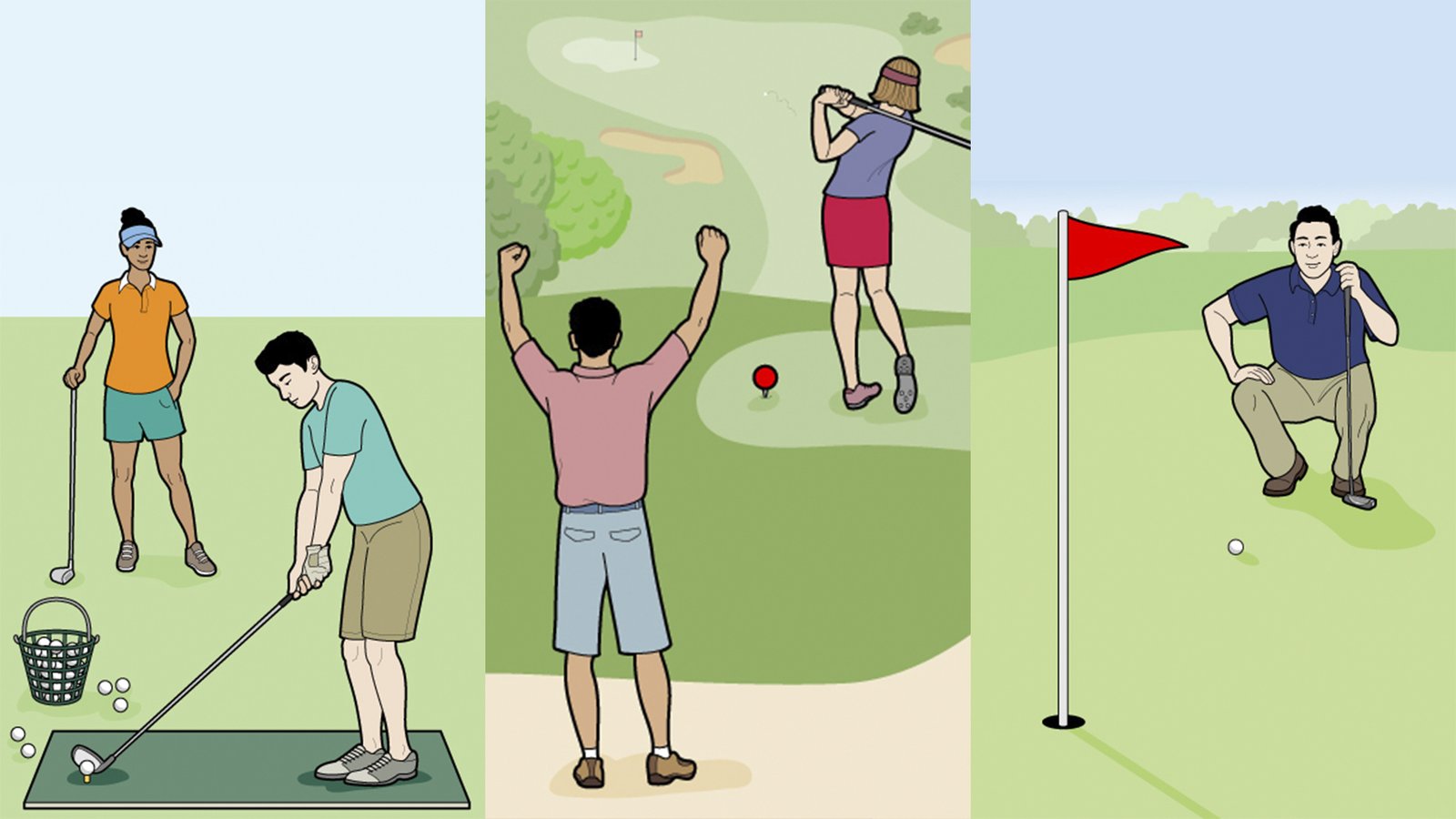
Are you a beginner golfer eager to improve your game? Look no further! In this article, you will discover a collection of invaluable golf tips specifically designed to help beginners navigate the unique challenges of the sport. Whether you’re struggling with your swing or unsure about proper etiquette on the course, we’ve got you covered. From mastering the basics to developing a winning mindset, these tips will set you on the path to becoming a confident and competent golfer in no time. Get ready to tee off with newfound skill and enthusiasm!
Choosing the Right Golf Clubs
When it comes to golf, having the right equipment is essential to improving your game. One of the first things you need to consider is your skill level. If you are just starting out, it’s best to choose a club set designed for beginners. These sets usually include a driver, a few irons, a hybrid, and a putter. They are designed to be forgiving and help you get the ball in the air more easily.
Once you have a basic set of clubs, it’s important to get fitted for them. This involves visiting a professional club fitter who will measure your height, arm length, and swing speed to determine the optimal club specifications for you. Getting fitted ensures that your clubs are the right length, have the correct lie angle, and have the appropriate shaft flex.
Speaking of shaft flex, it’s another important consideration when choosing golf clubs. The flexibility of the shaft can have a significant impact on your swing and ball flight. There are three main types of shaft flex: regular, stiff, and senior. If you have a slower swing speed, a more flexible shaft like senior flex might be more suitable. On the other hand, if you have a faster swing speed, a stiff shaft is recommended to help control your shots.
Lastly, you should consider the materials used in the construction of your golf clubs. Most clubs are made from either steel or graphite. Steel shafts are generally less expensive and offer more control, making them a good option for skilled players. Graphite shafts, on the other hand, are lighter and can provide more distance and flex, making them a popular choice for beginners and players with slower swing speeds.
Understanding the Grip
Having a correct grip is crucial for maintaining control and consistent performance throughout your golf swing. There are a few key points to keep in mind when gripping the club correctly. Firstly, make sure the grip is firm but not overly tight. This allows for a better feel of the clubhead and more control over your shots. It’s also important to position the grip in the fingers, not the palm of your hand, to ensure maximum flexibility and clubhead speed.
A neutral grip is highly recommended for most golfers. This means that both hands are positioned so that the “V” between your thumb and index finger points towards your right shoulder (for right-handed golfers). A neutral grip promotes a square clubface at impact and helps prevent slices or hooks. It’s worth practicing your grip until it becomes second nature, as a proper grip can greatly improve the consistency and accuracy of your shots.
Hand placement and pressure are additional elements to consider when gripping the club. The top hand (left hand for right-handed golfers) should be positioned slightly more on top of the grip, while the bottom hand (right hand for right-handed golfers) is positioned more underneath. As for pressure, a balanced grip with equal pressure from both hands is recommended. Gripping too tightly can restrict your swing, while gripping too lightly can lead to loss of control. Find the right balance that feels comfortable for you.

Mastering the Golf Swing
A proper golf swing requires a combination of proper stance, posture, and mechanics. Getting these fundamentals right can make a significant difference in your game. Let’s take a closer look at each element.
Your stance and posture are the foundation of a good swing. Stand with your feet shoulder-width apart and your knees slightly flexed. Your weight should be balanced evenly on both feet. Bend forward from your hips, keeping your back straight, and let your arms hang naturally. This posture ensures a stable base and allows for a full range of motion during your swing.
The backswing is the motion that precedes the downswing and sets up the power and accuracy of your shot. Start by turning your shoulders away from the target, keeping your left arm (for right-handed golfers) straight. Shift your weight to your right side and rotate your hips to create torque. The backswing should be smooth and controlled, allowing your club to reach the top of the swing on a proper plane.
The downswing is where the power and speed of your swing are generated. Begin by shifting your weight from your right side to your left side, simultaneously starting the movement with your hips. This motion should be initiated from the ground up, with your lower body leading the way. As your hands drop, allow the club to release naturally, making impact with the ball on a shallow angle. Focus on maintaining a smooth and balanced motion throughout the downswing.
The follow-through is the final part of the golf swing and plays a crucial role in the outcome of your shot. As you make contact with the ball, continue your swing with a full extension of your arms and a rotating motion of your body. Your weight should shift onto your front foot, and your chest should face the target. A proper follow-through ensures good balance, control, and a complete release of energy.
Learning to Aim and Align
Golf is a game of precision, and learning to aim and align properly can make a world of difference in your shot accuracy. Here are some tips to help you with this important aspect of the game.
Aiming your shot correctly starts with selecting a target. Often, golfers aim at the pin, but it’s important to consider the entire hole and any potential hazards. Pick a target on the fairway or a spot in the distance that aligns with your desired shot shape. Visualize the flight path of your ball towards that target and use it as a reference throughout your swing.
Aligning your feet and shoulders correctly is vital for ensuring your swing path matches your desired shot. To achieve this, stand behind the ball and envision a line running from your ball to the target. From this perspective, position your feet parallel to this line, adjusting if necessary to account for any intended draw or fade. Also, align your shoulders along the same line, as they have a direct impact on the swing path.
Using alignment tools, such as alignment sticks or clubs, can greatly assist in developing your aim and alignment skills. Simply place the alignment tool on the ground, parallel to your target line, and align your feet and shoulders accordingly. This visual aid helps train your eyes to recognize proper alignment and reinforces good habits.

Developing a Consistent Tempo
Tempo refers to the rhythm and timing of your swing, and it plays a significant role in your overall golf performance. Developing a consistent tempo can improve your shot consistency and help you maintain control. Let’s dive deeper into this aspect of the game.
Understanding the importance of tempo is the first step towards developing it. An appropriate tempo allows for a smooth transfer of energy from backswing to downswing and results in a more synchronized and efficient swing. It prevents rushing or jerky motions that can lead to inconsistent ball-striking. Consistency in tempo enables you to repeat your swing more easily, resulting in improved accuracy and distance control.
Practicing with a metronome is a great way to train your tempo. Set the metronome to a specific rhythm or beats per minute (BPM) and synchronize your swing with the sound. Start with a slower tempo and gradually increase the BPM as you get more comfortable. The metronome acts as a guide, helping you establish a consistent rhythm and pace.
Finding your ideal tempo is a personal journey that requires experimentation. Some golfers naturally have a faster tempo, while others are more comfortable with a slower pace. It’s important to find a tempo that feels natural to you and allows you to maintain control and balance throughout your swing. Experiment with different tempos during practice sessions and pay attention to the results. Over time, you’ll discover the tempo that suits your game best.
Mastering the Short Game
While the long game may get a lot of attention, mastering the short game is equally important, if not more, to improve your scores. The short game refers to shots played near or around the green, including wedge shots, chip shots, pitch shots, and putting. Let’s explore some key aspects of the short game.
Understanding wedge selection is crucial for success in the short game. The various wedges in your bag, such as the pitching wedge, gap wedge, sand wedge, and lob wedge, have different lofts and bounce angles. Learning the characteristics of each wedge and when to use them can greatly enhance your ability to execute different shots around the green. Practice with each wedge to get a feel for their distances and trajectories.
Chipping techniques are essential for getting the ball close to the hole from around the green. For chip shots, use a more narrow and forward stance, with the ball positioned slightly back in your stance. Keep your hands ahead of the ball and use a putting-like motion, focusing on making clean contact. Vary the club selection and trajectory to suit the situation and the amount of green you have to work with.
Pitching techniques come into play when you need to hit the ball higher and land it softly on the green. For pitch shots, use a wider stance and place the ball slightly forward in your stance. Allow for a fuller, more arcing swing that generates more height and spin. Focus on crisp ball contact and maintaining a smooth rhythm throughout the swing. Experiment with different club selections to control the distance and trajectory of your pitch shots.
Putting fundamentals are essential for lowering your scores. Start by developing a consistent putting stance and grip. Stand with your feet shoulder-width apart and slightly flexed knees. Maintain a light grip pressure and position your hands ahead of the ball. Keep your head steady and use a pendulum-like motion with your shoulders and arms. Practice distance control by working on lag putts and become proficient at reading the greens to gauge the break and speed.

Managing Course Strategy
As you progress in golf, developing course management skills becomes increasingly important. It’s not just about hitting great shots but also about making smart decisions and strategizing your way around the course. Here are some tips to help you improve your course strategy.
Understanding different course hazards is key to avoiding unnecessary trouble. Familiarize yourself with the layout of the course and identify potential hazards, such as water hazards, bunkers, and out-of-bounds areas. Take note of their locations and adjust your strategy accordingly. Sometimes playing safe and avoiding trouble is a better choice than trying to heroically tackle a difficult shot.
Deciding when to take risks is another important aspect of course management. While playing conservatively is often a wise choice, there are times when taking calculated risks can be rewarding. Evaluate the situation and assess the potential rewards and consequences of each shot. Sometimes taking the risk can lead to scoring opportunities, while other times it might be better to play it safe and focus on avoiding big numbers.
Developing course management skills requires experience and practice. Pay attention to how your favorite professional golfers approach different courses and holes. Study their decision-making process and try to emulate their strategies. With time and practice, you’ll build your own repertoire of course management techniques that suit your playing style and help you navigate different golf courses effectively.
Improving Physical Fitness
Golf may not always be associated with intense physical activity, but being in good physical condition can greatly enhance your game. It can improve your flexibility, strength, and endurance, allowing you to swing more effectively and avoid injuries. Here are some fitness tips to consider.
Flexibility exercises are important for maintaining a full range of motion in your swing and preventing muscle imbalances. Incorporate stretching exercises into your routine, focusing on areas such as your shoulders, hips, and core. Regular stretching helps improve your swing mechanics and can also aid in injury prevention.
Strength training specifically designed for golf can enhance your swing power and stability. Work on strengthening your key muscle groups, such as your core, glutes, and upper body. Exercises like squats, lunges, and exercises with resistance bands can help develop the strength needed for a powerful and controlled swing. Consult a fitness professional for a customized strength training program tailored to your needs.
Cardiovascular conditioning is essential for maintaining energy and focus throughout a round of golf. Engage in exercises that elevate your heart rate, such as jogging, cycling, or swimming. Improved cardiovascular fitness can help you combat fatigue during a round and also aid in recovery between rounds.
It’s worth noting that physical fitness is a long-term commitment and should be approached gradually. Start by incorporating small lifestyle changes, such as taking the stairs instead of the elevator or going for short walks. As your fitness improves, you can gradually increase the intensity and duration of your fitness activities. Remember, being physically fit not only benefits your golf game but also contributes to your overall health and well-being.

Developing Mental Toughness
Golf is as much a mental game as it is a physical one. Developing mental toughness is essential for staying focused, managing pressure, and performing at your best. Here are some strategies to help you strengthen your mental game.
Visualization techniques involve visualizing successful shots or desired outcomes before actually executing them. Take a few moments before each shot to imagine the trajectory, the distance, and the result you want to achieve. Visualize yourself confidently executing the shot and trust in your abilities. This mental preparation can enhance your confidence and improve your ability to execute under pressure.
Staying focused throughout a round of golf can be challenging, especially with distractions all around. Develop techniques to maintain concentration and ward off negative thoughts. Practice mindfulness techniques, such as deep breathing or focusing on a specific target, to keep your mind centered on the present moment. Refocus quickly after a bad shot or missed opportunity, as dwelling on past mistakes can hinder your performance.
Managing pressure and nerves is crucial for performing at your best when the stakes are high. Learn to embrace pressure as an opportunity rather than a threat. Develop pre-shot routines that help you relax and refocus before each shot. Engage in positive self-talk and use affirmations to boost your confidence. Visualize yourself handling pressure situations successfully and trust in your abilities.
Developing mental toughness is an ongoing process that requires mindfulness and practice. Incorporate mental training exercises into your practice sessions and tournaments. Consult with a sports psychologist if you need additional guidance and support. With time and commitment, you’ll strengthen your mental game and improve your ability to perform consistently under all circumstances.
Etiquette and Rules of Golf
Golf is a game of integrity and etiquette, and understanding the rules and etiquette is crucial for a smooth and enjoyable experience on the course. Let’s delve into the key aspects of golf etiquette and the basic rules of the game.
Understanding golf etiquette is important to ensure a respectful and enjoyable atmosphere on the course. Here are a few etiquette guidelines to keep in mind:
- Always be mindful of your pace of play and keep up with the group in front of you. If you’re slower than the group behind you, consider allowing them to play through.
- Repair any divots you make on the fairway and fix ball marks on the green.
- Be aware of your surroundings and avoid distracting other golfers during their shots.
- Keep noise to a minimum and respect the peace and tranquility of the course.
- Be conscious of where you walk and avoid stepping on other players’ putting lines.
- Be courteous and respectful to your fellow golfers, the course staff, and anyone else you encounter on the course.
Knowing the basic rules of golf is essential for fair play and minimizing penalties. Here are some fundamental rules to be aware of:
- Tee off behind the markers on each hole.
- Play the ball as it lies, unless otherwise allowed by a rule.
- If your ball lands out of bounds, add a penalty stroke and play a new ball from the designated drop zone.
- If your ball lands in a hazard, such as a water hazard or bunker, you have a few options. Consult the rules of golf for specific guidelines on how to proceed.
- Always mark your ball on the green to avoid interfering with other players’ lines.
- Keep an accurate score and record it after completing each hole.
Getting familiar with golf terminology is also recommended to better understand the game and communicate with other golfers. From “birdie” to “bogey,” learning the common golf terms adds to your enjoyment and engagement in the sport.
In conclusion, playing golf involves more than just swinging a club and hitting a ball. It requires careful consideration of various aspects, from choosing the right clubs to honing your swing mechanics, aiming and aligning, managing course strategy, improving physical fitness, developing mental toughness, and adhering to proper etiquette and rules. By following these tips and continuously practicing and learning, you’ll be well on your way to becoming a more skilled and confident golfer. Enjoy the journey and have fun on the golf course!
